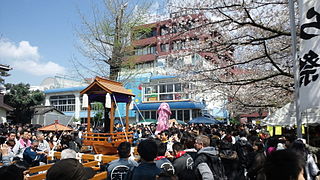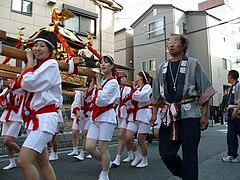Mikoshi
As mikoshi ( Japanese 神輿 , polite Omikoshi ( " venerable litter," also Shin'yo , "Gods litter")) is called in Japanese a portable shrine where the deity ( Kami ) at festivals from their building in Shinto shrine are led out .
It has a curved, ornate roof. At shrine festivals ( Matsuri ) these “gods litters” are carried by young men and women with the help of two to six girders. The girders brace themselves under the beams and carry it through the streets with loud, rhythmic calls. In many coastal regions of Japan they wade into the sea with the shrine to ask for a good catch.
Many festivals follow rules that have been handed down for generations. At the Hōnen Festival ( Hōnen-Matsuri ) z. B. The Mikoshi is worn by 42 year old men in white clothing. At some festivals the shrine is swung wildly back and forth by the porters.
During the festive season, the Mikoshi are placed in a special shrine (御 旅 所, O-tabisho ) after the parades . These should once have been more significant than the respective stationary shrine buildings.
photos
Mikoshi in Nikko
Sanja-Matsuri , Tōkyō
Kanamara-Matsuri , Kawasaki
Remarks
- ↑ Mikoshi of Tokugawa Ieyasu .
- ↑ Mikoshi of the Fukagawa Hachiman Shrine (Fukagawa-Hachimangu) in Tōkyō is the largest in the country.
- ↑ Holiday shrine at Mikumari Shrine (Yoshino) .
Web links
- Motosawa Masashi: "Shin'yo" . In: Encyclopedia of Shinto. Kokugaku-in , September 5, 2006 (English)









